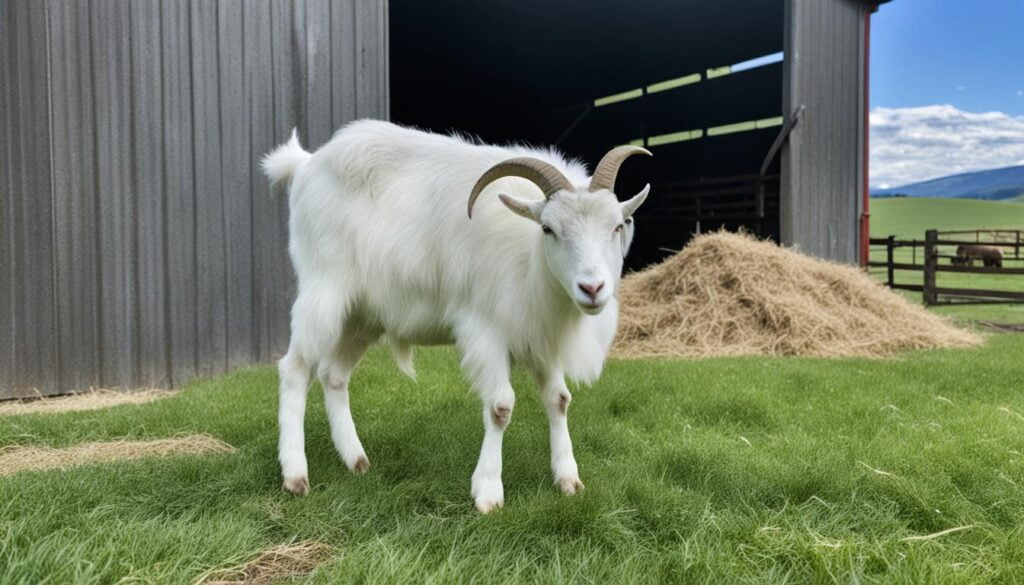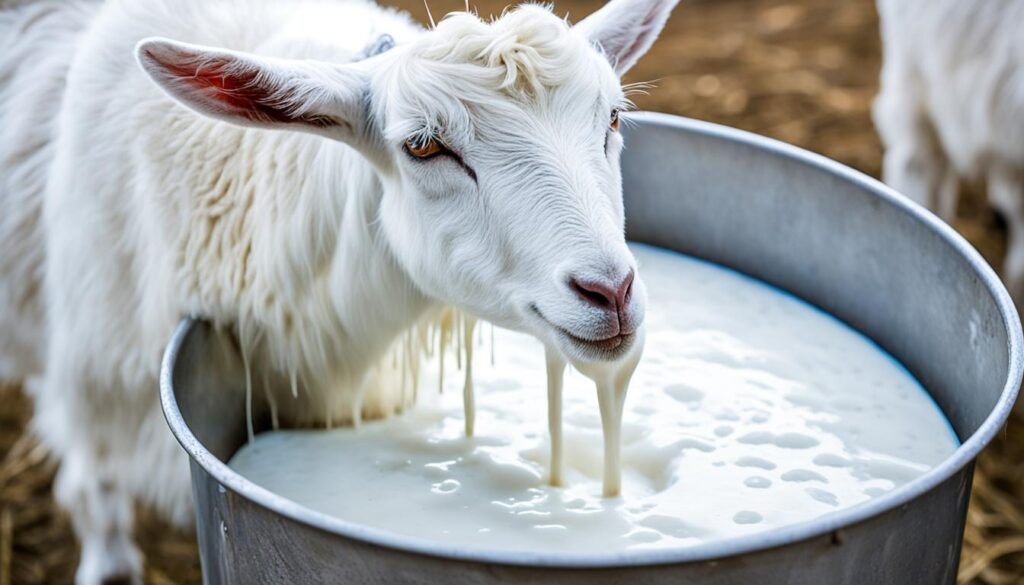Embarking on the journey of caring for mini Saanen goats satisfies the quest for a friendly and manageable dairy goat suited for the hobby farmer’s backyard setup. The miniature Saanen breed, with its amiable nature and moderate saanen goat size, makes an ideal addition to small-scale farming endeavors. As you seek mini saanens for sale, consider the nuances of their care—from companionship needs, ensuring at least two goats to maintain their social well-being, to shelter and nutrition that align with their distinct needs.
Whether you are well-versed in dwarf saanen goats or are considering your first foray into goat keeping, understanding the breed-specific requirements is paramount. These insights into mini saanen goat care are pivotal to creating a harmonious living space for your goats, and, in turn, a more fruitful and enjoyable farming experience for you.
Key Takeaways
- Choose mini Saanen goats for a petite and friendly dairy goat breed that’s perfect for small backyard farms.
- Ensure companionship for your goats by starting with at least a pair to promote their happiness and welfare.
- Adequate fencing and suitable shelter are critical to protect and accommodate these animals.
- Maintain a regular care routine for the health and productivity of your mini Saanen goats.
- Explore the economic benefits of goat keeping, from low feed costs to potential income from offspring.
- Contact respected breeders when looking to expand your herd with healthy mini Saanen goats for sale.
Discovering the Mini Saanen Goat: An Ideal Companion for Hobby Farming
As a hobby farmer, you know the joy and fulfillment that comes with raising animals that are a perfect fit for your lifestyle. Enter the Mini Saanen goat, a delightful and manageable crossbreed born from the saanen pygmy cross. These small saanen goats are not just adorable; they encapsulate all the mini saanen goat characteristics that make them suitable for smaller homesteads and backyard farms.
Imagine starting your day greeted by baby saanen goats prancing around the farm, their playful antics a heartwarming sight that underscores why these small breeds are cherished by farmers like you. Whether through purchase or breeding, adding these miniature companions to your land is more than just an investment; it’s bringing in family members who will thrive in your care.
Their saanen goat size is advantageous, as they require less space and feed than their larger counterparts, yet still provide plenty of personality and utility. Compatibility with other animals is also a mark of the Mini Saanen’s adaptability, making them a seamless addition to a diverse menagerie.
To guide you in understanding what sets these goats apart, here’s a comparative table outlining the key traits of Mini Saanen goats compared to their larger Saanen relatives:
| Characteristic | Mini Saanen Goat | Standard Saanen Goat |
|---|---|---|
| Size/Height at Withers | Smaller (up to 22 inches) | Larger (up to 30 inches) |
| Temperament | Docile and Friendly | Docile and Friendly |
| Space Requirements | Less Space Needed | More Space Needed |
| Feed Consumption | Lesser Feed | More Feed |
| Milk Production | Slightly Lower Yield | Higher Yield |
When considering the addition of these animals to your farm, remember the importance of sourcing from reputable breeders. Healthy, well-tempered goats are essential for a joyful and rewarding hobby farming venture. With the right companions by your side, your Mini Saanen goats will be more than livestock—they will be a source of happiness, productivity, and an enchanting sight on your lovingly tended land.
Essential Care Requirements of Mini Saanen Goats
As a hobby farmer, nurturing your mini Saanen goats for optimal goat health involves a mixture of dedication, knowledge, and practical maintenance. Striving for excellence in mini Saanen goat maintenance not only ensures the vitality of your livestock but also coincides with the rewarding experience of dairy farming. To aid you in this endeavor, here are specific guidelines to elevate your Saanen goat care practices and understand the distinct needs of these beloved dairy goat breeds.
First and foremost, let’s shed some light on their housing necessities. A robust shelter keeps Saanens safe and dry, considering their vulnerability to respiratory conditions. Opt for a well-ventilated but draft-free barn, adorned with a thick layer of bedding—barley straw being a prime choice for comfort and hygiene.
- Bedding should be replaced frequently to reduce moisture and prevent the spread of parasites.
- Fencing should be as much about security as it is about safety: Stand strong against the notorious escape artists that goats can be.
- Never underestimate the power of companionship; pairing goats can thwart the woes of loneliness and stress.
Brush up on the dietary needs of your mini Saanens. A balanced intake of hay, fresh water, and minerals must be a staple routine. Remember, though—they don’t say ‘as greedy as a goat’ for nothing. Monitor their food consumption to avoid the pitfalls of over or underfeeding.
A mindful Saanen is a munching Saanen; a goat’s health can often be gauged by their appetite.
Let’s not forget, staying atop their health with regular vet visits and vaccinations is non-negotiable. And when nature calls during breeding season, be ready with access to responsible and stress-free breeding services. Doing so fulfills their reproductive needs and ensures a continuum of dairy production.
The table below captures the essence of what it takes to sustain the flourishing life-force of your mini Saanens:
| Care Aspect | Recommended Actions | Impact on Goat Health |
|---|---|---|
| Shelter | Provide a draft-free environment with proper ventilation | Reduces the risk of respiratory diseases |
| Bedding | Use absorbent materials like barley straw and replace regularly | Enhances comfort and sanitation |
| Fencing | Install secure fencing to prevent escapes | Keeps goats safely within your property |
| Companionship | Maintain at least a pair of goats to provide necessary social interaction | Prevents stress and promotes mental well-being |
| Nutrition | Balanced diet with hay, minerals, and clean water | Supports growth and lactation, prevents disease |
| Health Management | Regular check-ups, deworming, vaccinations | Ensures prevention and early detection of health issues |
| Breeding | Access to ethical breeding services | Continues the cycle of reproduction and milk production |
Meticulous adherence to the above guidelines can pivot the scales in favor of your goats’ longevity and yields, proving time and again that in the realm of dairy goat breeds, care is the true catalyst of prosperity.

Milk Production and Breeding Practices for the Mini Saanen Goat
As you delve into the world of dairy goat milk production with your mini Saanen goats, understanding the nuances of freshening and selective breeding is essential. Achieving a successful lactation period, the traits you nurture within your herd, and the way you rear the saanen goat offspring have significant impacts on the productivity and health of your farm.
Understanding Freshening and Milk Yield
When your mini Saanen doe experiences freshening, which signifies the onset of milk production post-birth, you’ll observe an initial increase in goat milk yield. Managing this peak period effectively allows you to maximize dairy production, ensuring fresh supply for both home use and market. Remember, a well-cared-for mini Saanen can provide up to half a gallon of milk a day after freshening in goats, with production steadying over time.

Tracking the lactation curve not only helps in scheduling breeding sessions but also in understanding mini saanen lactation patterns, crucial for planning around your household and market demands.
The Importance of Selective Breeding in Mini Saanens
Selective breeding in goats isn’t merely a tool for enhancing certain mini saanen traits; it’s a cornerstone of maintaining a vigorous and productive herd. Through selective breeding, you can focus on dwarf saanen genetics that favor desired characteristics, from increased butterfat content in milk to improved temperament for easier handling.
By practicing selective breeding, you’re crafting not just a herd but a legacy of mini saanen goats that resonates with your farming philosophy.
Raising Kids: From Birth to Weaning
A pivotal stage in your mini saanen goat’s life is the journey from birth to weaning. Nourishing saanen goat offspring care from the get-go, ensures they grow robustly, equipped for a smooth transition to solid foods. The weaning saanen kids process typically starts after eight weeks of nursing—a critical window for immunity and development.
| Stage | Nutritional Needs | Care Tips |
|---|---|---|
| Birthing (Day 0) | Colostrum intake for kids | Ensure a quiet, clean birthing environment |
| Early Nursing (Weeks 1-4) | Frequent nursing, mother’s milk | Monitor health of both doe and kids |
| Late Nursing (Weeks 4-8) | Introduction to hay and water | Socialization with herd |
| Weaning (Post 8 weeks) | Transition to complete feed | Gradual weaning to avoid stress |
Raising baby saanen goats asks for dedication, ensuring that each chore from feeding to health checks is performed with attentiveness, prepping these kids for a thriving life ahead.
Advanced Management Techniques for the Flourishing Mini Saanen Herd
As you delve deeper into the world of hobby farming, understanding that the prosperity of your mini Saanen goats stems from a harmonious blend of nutrition, environment, and health practices is crucial. Each aspect of care is a cog in the well-oiled machine that maintains the vitality and productivity of your herd. Let’s explore the advanced management techniques that will ensure your mini Saanens not only survive but truly thrive.
Comprehensive Feeding Strategies for Optimal Health
Your mini Saanen’s well-being begins with goat feed management. A delicate balance in their dairy goat diet is essential, with the inclusion of quality Chaffhaye and natural forage to fulfill their nutritional needs. It’s pivotal to get the balance right—as too much can lead to obesity and too little to malnutrition, with consequences on both their health and your farm’s productivity. Remember, the growth and milk production you’re aiming for are results of meticulous attention to mini Saanen nutrition, tailored to each goat’s life stage and physical demands.
Creating a Safe and Stimulating Environment
In managing mini Saanen goat shelter needs, prioritize environments that marry safety with enrichment. Your goats need protection from the elements and a habitat that caters to their playful spirit. Effective dairy goat living conditions prevent stress and encourage physical activity, critical for their mental health. So when designing safe goat housing, incorporate features that allow for climbing and exploration, which are innate to the curious nature of your Saanens. A happy goat is a healthy goat, and a well-thought-out living space is an investment in your herd’s future.
Health Check-ups and Preventative Care Practices
Maintaining peak mini Saanen goat health is non-negotiable, and this is where preventative measures and regular veterinary oversight come into play. Implementing routine health protocols such as vaccinations and deworming will shield your herd from common threats. Staying proactive with preventative goat care measures will also help catch early signs of disease, significantly reducing potential impacts. As you oversee your herd, keep in mind that dairy goat wellbeing is reflective of your dedication to providing comprehensive care that safeguards not just the individual goats but the sustainability of your entire backyard setup.

